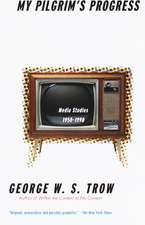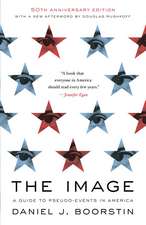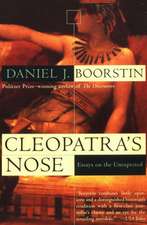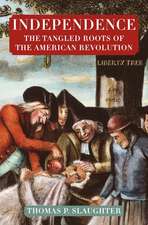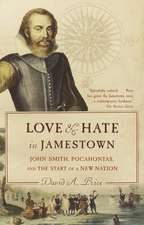Exploring Lewis and Clark: Reflections on Men and Wilderness
Autor Thomas P. Slaughteren Limba Engleză Paperback – 31 ian 2004
Thomas P. Slaughter interrogates the explorers’ dreams, how they wrote and what they aimed to possess, their interactions with animals, Indians, and each other, their sense of themselves as leaders and men, and why they feared that they had failed their nation and President. Slaughter’s Lewis and Clark are more confused, frightened, courageous, and flawed than in previous accounts. They are more human, their expedition more dramatic, and thus their story is more revealing about our own relationships to history and myth.
Preț: 122.04 lei
Nou
Puncte Express: 183
Preț estimativ în valută:
23.35€ • 24.45$ • 19.32£
23.35€ • 24.45$ • 19.32£
Carte tipărită la comandă
Livrare economică 07-21 aprilie
Preluare comenzi: 021 569.72.76
Specificații
ISBN-13: 9780375700712
ISBN-10: 0375700714
Pagini: 258
Ilustrații: 14 ILLUSTRATIOSN
Dimensiuni: 133 x 205 x 13 mm
Greutate: 0.24 kg
Editura: Vintage Publishing
ISBN-10: 0375700714
Pagini: 258
Ilustrații: 14 ILLUSTRATIOSN
Dimensiuni: 133 x 205 x 13 mm
Greutate: 0.24 kg
Editura: Vintage Publishing
Notă biografică
Thomas P. Slaughter is the Andrew V. Tackes Professor of History at the University of Notre Dame. He is the award-winning author of three previous books—most recently, The Natures of John and William Bartram—and is the editor of three others, including the Library of America edition of William Bartram: Travels and Other Writings. He lives in South Bend, Indiana, with his wife and two children.
Extras
Chapter 1
Dreams
In the beginning the surface of the earth was all water and there was darkness." In this darkness and on these waters First Creator and Lone Man walked. They came across a duck-a mud hen in some versions-diving under the water and were curious. They asked the duck what she ate and she returned from a dive with sand in her beak, which they used to create the earth.
The First Creator made broad valleys, hills, coulees with timber, mountain streams, springs, and, as creatures, the buffalo elk, black-tailed and white-tailed antelope, mountain sheep and all other creatures useful to mankind for food and clothing. He made the valleys and coulees as shelter for the animals as well as for mankind. He set lakes far apart. Lone Man created for the most part level country with lakes and small streams and rivers far apart. The animals he made lived some of them in the water, like beaver, otter, and muskrat. Others were the cattle of many colors with long horns and long tails, moose, and other animals.
First Creator and Lone Man compared their creations and found fault with each other's. "First Creator said of the land north of the Missouri River, 'The things you have created do not meet with my approval. The land is too level and affords no protection to man.' " Lone Man thought that First Creator had made the land south of the Missouri too rough. They agreed, though, to leave all as it was and to allow humans to use the south side until its resources were exhausted and then move across the river to the north. "So it was agreed between them and both blessed their creation and the two parted."
Lone Man watched humans multiply and was pleased. He worried, though, about evil spirits among them and decided to be born as a man. He chose a Mandan virgin for his mother, turned himself into a kernel of corn, and entered her when she ate him. "In the course of time the child was born and he grew up like other children, but he showed unusual traits of purity and as he grew to manhood he despised all evil and never even married. Everything he did was to promote goodness."
There are other stories about the creations, about the origins of Lone Man and his good deeds on behalf of humans. Mandans said they had come from a cavern on the north bank of a river at the ocean's shore. They told Lewis and Clark that they came from a village under the earth, from which they climbed on a grapevine. They knew that Lone Man never married or engaged in a sexual act. They believed that light-complexioned people would come from the east, because that was prophesized from the time of creation. And they anticipated trouble from the white men when fur traders and explorers arrived. When First Creator saw the whites that Lone Man created, he disapproved. "You have made a queer kind of men-they will always be greedy!"
"In the beginning God created the Heaven, and the Earth." Important stories repeat. The earth is created three times in Genesis, and the Mandan told their creation story in multiple versions too. "So God created man in his own Image, in the Image of God created he him; male and female created he them." Again: "And the LORD God formed man of the dust of the ground, & breathed into his nostrils the breath of life; and man became a living soul." Lone Man breathed life into his creations too, and not always in the same way.
Myths vary in the repetition. Both the variation and the repetition are essential. "And God spoke to Noah, saying, Go forth from the Ark, thou, and thy wife, and thy sons, and thy sons' wives with thee: Bring forth with thee every living thing that is with thee, of all flesh, both of fowl and cattle, and of every creeping thing that creeps upon the earth, that they may breed abundantly in the earth, and be fruitful, and multiply upon the earth." Myths, by their very essence, can be and must be replicated. We repeat them-both the telling and the acts-over and over again.
Myths create binaries-heaven and earth, man and woman, good and evil, beginning and end, first and last, God and man. The middle ground between these binaries is scary, violent, evil or holy, and unnatural-a place to avoid (taboo) or approach through ritual in an attempt to resolve the danger of the binary or opposite. These are places for shamans. Even Jesus and Lone Man faced great danger in these liminal (in-between) spots when they became humans. "Now the serpent was more subtle than any beast of the field, which the LORD God had made." That, it seems, was its undoing. "And the LORD God said to the Serpent, Because you have done this, you are cursed above all cattle, and above every beast of the field; upon your belly shall you go, and dust shall you eat, all the days of thy life." Cursed, again, the serpent remains between God and humans, man and woman, nature and the unnatural, although always identified more closely with the second in each of these binaries-humans, woman, and the unnatural-thereby branding each by association. We are, in the Genesis myth, forever snake and not snake over and over again.
Where, Lewis and Clark asked the Mandan, did your people come from? We live under the water, where we have a village and gardens. Then, before we remember, we come out through a hole and settle on the Missouri River. Lone Man is born to a Mandan virgin, who conceives him by ingesting a kernel of corn. . . . "Several little anecdotes told me today," Clark wrote, not even bothering to enter the (to him) silly stories that he dismissed charmingly. Ignoring the belief of some Mandans that they came from the south-First Creator's land-and the west-a cavern on the banks of a river at the ocean's edge-Clark postulated that they were descended from "a more civilized state" to the east.
The explorers believed that the Mandans were too "white" to be full-blooded Indians. The tribe's comparatively fair complexion was a sign of racial connections to Europe, Lewis and Clark reasoned. The Indians spoke of a garden and a great flood, demonstrating shared mythical origins. The explorers sought other evidence of the Mandans' biblical knowledge, since an American "lost tribe" remained a distinct possibility, as did a Welsh genealogy. There were stories about Prince Madoc's discovery of North America and possibly some Mandans had heard about fair-complexioned ancestors who came from the east with stories about a garden, a snake, and a flood.
Such apparently simple issues as directionality were devilishly difficult to establish with the Mandan, though. Some came from below; some came from over there; some responded positively to Clark's suggestion that they came from the east. More than one traveler remarked that Indian responses to such questions were useless. According to the fur trader David Thompson, "persons who pass through the country often think the answers the Indians give are their real sentiments. The answers are given to please the querist." Hospitality dictated that answers please the guest, so the Mandan told Clark what they thought he wanted to hear. He did not appreciate their stories set westward, to the south, or underground. If he wanted them to say that they came from the east, they would provide that response, too. The eastern origin and the descent from civilization were Clark's theories. The directions were part of his mythical baggage. The desire for racial linkages between Indians and Europeans was his culture's, too. The Mandans knew better and did not share the dream that their peoples were one. Their "charming anecdotes" were true. They knew who the white men were and where they had come from.
Mandans saw their myths unfolding in the present, as did Hidatsa, Nez Perce, Shoshone, and Sahaptan-speaking peoples whom Lewis and Clark met, while the explorers believed their culture's origin stories in the past tense if they believed them at all. These explorers, like most educated Americans of their day and ours, alienated the teller from the tale, the present from the past and future, and humans from the natural world in which the stories were embedded. When Lewis or Clark asked a question in the past tense, Mandans gave answers that seemed unresponsive. The explorers wanted "facts" they could write down. What they got often seemed inappropriate for transcription. Readers of their journals are left, then, with vague references to the stories and ridicule of the storytellers.
Where are you from? Lewis and Clark asked the Nez Perce. We are the Nee-mee-poo, the "People," who live in this place. But where did you live before you came here? Ah, there are stories about a time before the memory of humans when the earth was covered in water.
The water wandered among the pine trees with no paths to follow. There were only animals then, which made the earth ready for the arrival of the People. Skunk, who was a great mystery man, and Bear wanted to dig a path for the water so that the People could find berries and roots on dry land. Coyote, who liked to do big things, volunteered to dig a ditch from the ocean, through the mountains and onto the level plains. He dug high, which is the falls, and low, which is the valley. "So were the rivers formed and things made ready for The People."
Lewis did not bother to write such answers down and neither did Clark on the outward leg of their journey. They could, however, try to rephrase the question. How is it that your people came to live in this valley? Ah, you want to know about Bear and the boy.
A boy wandered in the mountains at the time when the People were coming to take the place of animals on earth. He could not find his parents, but did meet up with the grizzly bear. "Bear growled until the mountains shook and echoed his anger." The boy, unlike the animals, did not show fear and answered bear's growls in calm words. "I can only die. Death is only part of life. I am not afraid." Bear was full of wonder at the boy's bravery and declared him a member of a superior race. In admiration, Bear flipped the boy up on his back and showed him the homes of beaver, moose, elk, deer, and buffalo. He showed the boy the path through the mountains to a beautiful valley full of edible game, berries, and roots. Bear then took the boy back to the People and the boy showed them the way to the valley and all the secrets that Bear had shared with him.
How frustrating for Lewis and Clark. Even if you want to, even if you take it seriously as an origins myth, the story cannot be captured in writing. Its essence is embedded in the telling-the voice that growls the grizzly's words, the teeth that chomp, and the snarling mouth. The audience should include children. The listeners must display the boy's fear, speak his lines courageously, and portray the excitement in his eyes as he tells of the wonders he has beheld. They should know the landmarks to which the story refers-the particular rock, the specific river, the mountain pass through which Bear carried the boy. The meaning is not in the words alone; it is in the telling.
The Indians whom Lewis and Clark met lived in much closer proximity to the nonhuman world than the explorers ever would. Those who used bows and arrows literally had to get closer to their prey than the long-rifled hunters of the expedition. They were in better communication with nature, listening more effectively and feeling more listened-to. They were emotionally and empathetically closer to nature, apprentices to the animals around them and ever alert to the wisdom, the power, and the mysteries that nature has to share.
Clark fared no better with Hidatsa informers than he had with the Mandan, than he would with the Shoshone or Nez Perce. Hidatsa men told him "many extraordinary stories." When he redrafted the entry for that day, Clark noted again that he walked with the Hidatsa chief and interpreters, but left out even the vague reference to their stories. Clearly their answers were "extraordinary" in a pejorative sense only, and thus not worth writing down. They were unbelievable, incredible, fantastic, and unresponsive. Clark wanted facts, not superstitions, and he wanted honest answers to his straightforward inquiries. Where did your people come from? There is a lake on the bottomlands of the Missouri River. People live in the lake under the water, which is very deep. You can hear their voices talking or singing. Sometimes you can hear their dogs barking and their drums when they are dancing. The past and the present, nature and humans, are one in the story.
Where did you come from? "The [Mandan] chief pointed out several places," Clark wrote on the expedition's return journey, "where he said his nation formerly lived and related some extraordinary stories of their tradition." Let me show you; we come from here-this rock, that lake, the mud or outcropping over there. Places were not passive settings to Clark's Mandan respondent. Experiences were not separable from the places where they occurred. Locales were not interchangeable. Places were active participants and often the source of an event. Space was undifferentiated from time. Space and time apparently existed in a continuum, a cycle that was neither linear nor past; the future came in its own time as it did before.
It made sense to the Mandan, Hidatsa, and Nez Perce respondents that the explorers were looking for places, but they may have failed to comprehend why the white men wanted to know where the ocean, the mountains, or the source of the Missouri was. It made less sense to them than it did to Lewis and Clark that the explorers were in a hurry to get to a mountain, felt late reaching the source of a river, or had no time to be here rather than there. The expedition's journals embodied Lewis's and Clark's sense of linear, sequential time as an objective entity divorced from experience in the present.
How could you be late for a mountain? The notion made no sense at all. To those Mandan, Nez Perce, and Hidatsa who experienced place as animate and experience as inherently spontaneous and temporally dynamic, the explorers' race to be "first" would have appeared irrational.
In one story that Clark did write down during his second visit with the Mandan, the people he spoke to recalled coming out of the ground where they lived. A grapevine grew up from their village through a hole in the earth. When they looked up the vine, they could see light. Some of the braver ones among them climbed the plant. When they got to the top, they saw buffalo, grapes, plums, and other animals and plants good to eat.
From the Hardcover edition.
Dreams
In the beginning the surface of the earth was all water and there was darkness." In this darkness and on these waters First Creator and Lone Man walked. They came across a duck-a mud hen in some versions-diving under the water and were curious. They asked the duck what she ate and she returned from a dive with sand in her beak, which they used to create the earth.
The First Creator made broad valleys, hills, coulees with timber, mountain streams, springs, and, as creatures, the buffalo elk, black-tailed and white-tailed antelope, mountain sheep and all other creatures useful to mankind for food and clothing. He made the valleys and coulees as shelter for the animals as well as for mankind. He set lakes far apart. Lone Man created for the most part level country with lakes and small streams and rivers far apart. The animals he made lived some of them in the water, like beaver, otter, and muskrat. Others were the cattle of many colors with long horns and long tails, moose, and other animals.
First Creator and Lone Man compared their creations and found fault with each other's. "First Creator said of the land north of the Missouri River, 'The things you have created do not meet with my approval. The land is too level and affords no protection to man.' " Lone Man thought that First Creator had made the land south of the Missouri too rough. They agreed, though, to leave all as it was and to allow humans to use the south side until its resources were exhausted and then move across the river to the north. "So it was agreed between them and both blessed their creation and the two parted."
Lone Man watched humans multiply and was pleased. He worried, though, about evil spirits among them and decided to be born as a man. He chose a Mandan virgin for his mother, turned himself into a kernel of corn, and entered her when she ate him. "In the course of time the child was born and he grew up like other children, but he showed unusual traits of purity and as he grew to manhood he despised all evil and never even married. Everything he did was to promote goodness."
There are other stories about the creations, about the origins of Lone Man and his good deeds on behalf of humans. Mandans said they had come from a cavern on the north bank of a river at the ocean's shore. They told Lewis and Clark that they came from a village under the earth, from which they climbed on a grapevine. They knew that Lone Man never married or engaged in a sexual act. They believed that light-complexioned people would come from the east, because that was prophesized from the time of creation. And they anticipated trouble from the white men when fur traders and explorers arrived. When First Creator saw the whites that Lone Man created, he disapproved. "You have made a queer kind of men-they will always be greedy!"
"In the beginning God created the Heaven, and the Earth." Important stories repeat. The earth is created three times in Genesis, and the Mandan told their creation story in multiple versions too. "So God created man in his own Image, in the Image of God created he him; male and female created he them." Again: "And the LORD God formed man of the dust of the ground, & breathed into his nostrils the breath of life; and man became a living soul." Lone Man breathed life into his creations too, and not always in the same way.
Myths vary in the repetition. Both the variation and the repetition are essential. "And God spoke to Noah, saying, Go forth from the Ark, thou, and thy wife, and thy sons, and thy sons' wives with thee: Bring forth with thee every living thing that is with thee, of all flesh, both of fowl and cattle, and of every creeping thing that creeps upon the earth, that they may breed abundantly in the earth, and be fruitful, and multiply upon the earth." Myths, by their very essence, can be and must be replicated. We repeat them-both the telling and the acts-over and over again.
Myths create binaries-heaven and earth, man and woman, good and evil, beginning and end, first and last, God and man. The middle ground between these binaries is scary, violent, evil or holy, and unnatural-a place to avoid (taboo) or approach through ritual in an attempt to resolve the danger of the binary or opposite. These are places for shamans. Even Jesus and Lone Man faced great danger in these liminal (in-between) spots when they became humans. "Now the serpent was more subtle than any beast of the field, which the LORD God had made." That, it seems, was its undoing. "And the LORD God said to the Serpent, Because you have done this, you are cursed above all cattle, and above every beast of the field; upon your belly shall you go, and dust shall you eat, all the days of thy life." Cursed, again, the serpent remains between God and humans, man and woman, nature and the unnatural, although always identified more closely with the second in each of these binaries-humans, woman, and the unnatural-thereby branding each by association. We are, in the Genesis myth, forever snake and not snake over and over again.
Where, Lewis and Clark asked the Mandan, did your people come from? We live under the water, where we have a village and gardens. Then, before we remember, we come out through a hole and settle on the Missouri River. Lone Man is born to a Mandan virgin, who conceives him by ingesting a kernel of corn. . . . "Several little anecdotes told me today," Clark wrote, not even bothering to enter the (to him) silly stories that he dismissed charmingly. Ignoring the belief of some Mandans that they came from the south-First Creator's land-and the west-a cavern on the banks of a river at the ocean's edge-Clark postulated that they were descended from "a more civilized state" to the east.
The explorers believed that the Mandans were too "white" to be full-blooded Indians. The tribe's comparatively fair complexion was a sign of racial connections to Europe, Lewis and Clark reasoned. The Indians spoke of a garden and a great flood, demonstrating shared mythical origins. The explorers sought other evidence of the Mandans' biblical knowledge, since an American "lost tribe" remained a distinct possibility, as did a Welsh genealogy. There were stories about Prince Madoc's discovery of North America and possibly some Mandans had heard about fair-complexioned ancestors who came from the east with stories about a garden, a snake, and a flood.
Such apparently simple issues as directionality were devilishly difficult to establish with the Mandan, though. Some came from below; some came from over there; some responded positively to Clark's suggestion that they came from the east. More than one traveler remarked that Indian responses to such questions were useless. According to the fur trader David Thompson, "persons who pass through the country often think the answers the Indians give are their real sentiments. The answers are given to please the querist." Hospitality dictated that answers please the guest, so the Mandan told Clark what they thought he wanted to hear. He did not appreciate their stories set westward, to the south, or underground. If he wanted them to say that they came from the east, they would provide that response, too. The eastern origin and the descent from civilization were Clark's theories. The directions were part of his mythical baggage. The desire for racial linkages between Indians and Europeans was his culture's, too. The Mandans knew better and did not share the dream that their peoples were one. Their "charming anecdotes" were true. They knew who the white men were and where they had come from.
Mandans saw their myths unfolding in the present, as did Hidatsa, Nez Perce, Shoshone, and Sahaptan-speaking peoples whom Lewis and Clark met, while the explorers believed their culture's origin stories in the past tense if they believed them at all. These explorers, like most educated Americans of their day and ours, alienated the teller from the tale, the present from the past and future, and humans from the natural world in which the stories were embedded. When Lewis or Clark asked a question in the past tense, Mandans gave answers that seemed unresponsive. The explorers wanted "facts" they could write down. What they got often seemed inappropriate for transcription. Readers of their journals are left, then, with vague references to the stories and ridicule of the storytellers.
Where are you from? Lewis and Clark asked the Nez Perce. We are the Nee-mee-poo, the "People," who live in this place. But where did you live before you came here? Ah, there are stories about a time before the memory of humans when the earth was covered in water.
The water wandered among the pine trees with no paths to follow. There were only animals then, which made the earth ready for the arrival of the People. Skunk, who was a great mystery man, and Bear wanted to dig a path for the water so that the People could find berries and roots on dry land. Coyote, who liked to do big things, volunteered to dig a ditch from the ocean, through the mountains and onto the level plains. He dug high, which is the falls, and low, which is the valley. "So were the rivers formed and things made ready for The People."
Lewis did not bother to write such answers down and neither did Clark on the outward leg of their journey. They could, however, try to rephrase the question. How is it that your people came to live in this valley? Ah, you want to know about Bear and the boy.
A boy wandered in the mountains at the time when the People were coming to take the place of animals on earth. He could not find his parents, but did meet up with the grizzly bear. "Bear growled until the mountains shook and echoed his anger." The boy, unlike the animals, did not show fear and answered bear's growls in calm words. "I can only die. Death is only part of life. I am not afraid." Bear was full of wonder at the boy's bravery and declared him a member of a superior race. In admiration, Bear flipped the boy up on his back and showed him the homes of beaver, moose, elk, deer, and buffalo. He showed the boy the path through the mountains to a beautiful valley full of edible game, berries, and roots. Bear then took the boy back to the People and the boy showed them the way to the valley and all the secrets that Bear had shared with him.
How frustrating for Lewis and Clark. Even if you want to, even if you take it seriously as an origins myth, the story cannot be captured in writing. Its essence is embedded in the telling-the voice that growls the grizzly's words, the teeth that chomp, and the snarling mouth. The audience should include children. The listeners must display the boy's fear, speak his lines courageously, and portray the excitement in his eyes as he tells of the wonders he has beheld. They should know the landmarks to which the story refers-the particular rock, the specific river, the mountain pass through which Bear carried the boy. The meaning is not in the words alone; it is in the telling.
The Indians whom Lewis and Clark met lived in much closer proximity to the nonhuman world than the explorers ever would. Those who used bows and arrows literally had to get closer to their prey than the long-rifled hunters of the expedition. They were in better communication with nature, listening more effectively and feeling more listened-to. They were emotionally and empathetically closer to nature, apprentices to the animals around them and ever alert to the wisdom, the power, and the mysteries that nature has to share.
Clark fared no better with Hidatsa informers than he had with the Mandan, than he would with the Shoshone or Nez Perce. Hidatsa men told him "many extraordinary stories." When he redrafted the entry for that day, Clark noted again that he walked with the Hidatsa chief and interpreters, but left out even the vague reference to their stories. Clearly their answers were "extraordinary" in a pejorative sense only, and thus not worth writing down. They were unbelievable, incredible, fantastic, and unresponsive. Clark wanted facts, not superstitions, and he wanted honest answers to his straightforward inquiries. Where did your people come from? There is a lake on the bottomlands of the Missouri River. People live in the lake under the water, which is very deep. You can hear their voices talking or singing. Sometimes you can hear their dogs barking and their drums when they are dancing. The past and the present, nature and humans, are one in the story.
Where did you come from? "The [Mandan] chief pointed out several places," Clark wrote on the expedition's return journey, "where he said his nation formerly lived and related some extraordinary stories of their tradition." Let me show you; we come from here-this rock, that lake, the mud or outcropping over there. Places were not passive settings to Clark's Mandan respondent. Experiences were not separable from the places where they occurred. Locales were not interchangeable. Places were active participants and often the source of an event. Space was undifferentiated from time. Space and time apparently existed in a continuum, a cycle that was neither linear nor past; the future came in its own time as it did before.
It made sense to the Mandan, Hidatsa, and Nez Perce respondents that the explorers were looking for places, but they may have failed to comprehend why the white men wanted to know where the ocean, the mountains, or the source of the Missouri was. It made less sense to them than it did to Lewis and Clark that the explorers were in a hurry to get to a mountain, felt late reaching the source of a river, or had no time to be here rather than there. The expedition's journals embodied Lewis's and Clark's sense of linear, sequential time as an objective entity divorced from experience in the present.
How could you be late for a mountain? The notion made no sense at all. To those Mandan, Nez Perce, and Hidatsa who experienced place as animate and experience as inherently spontaneous and temporally dynamic, the explorers' race to be "first" would have appeared irrational.
In one story that Clark did write down during his second visit with the Mandan, the people he spoke to recalled coming out of the ground where they lived. A grapevine grew up from their village through a hole in the earth. When they looked up the vine, they could see light. Some of the braver ones among them climbed the plant. When they got to the top, they saw buffalo, grapes, plums, and other animals and plants good to eat.
From the Hardcover edition.
Recenzii
"Scintillating. . . . Delves deep and asks questions that will forever change [our] reading of these men." —Newsday
"Adds new and fascinating dimensions to our appreciation of the Corps of Discovery and their brave trek through the American West." —The Times-Picayune
“A rueful reading of the historical record that delights in considering the thorniest questions within it.” —The Washington Post
"Slaughter successfully achieves his goal of delving beneath the surface of the journals...Raise[s] interesting questions about Lewis and Clark, and shows that we shouldn't take everything we read in the journals as truth." —The Seattle Times
“Fascinating… Through close attention to the explorers’ own accounts of their journey, Slaughter probes the threats that confronted Lewis and Clark at every turn.” – The Times-Picayune
"Adds new and fascinating dimensions to our appreciation of the Corps of Discovery and their brave trek through the American West." —The Times-Picayune
“A rueful reading of the historical record that delights in considering the thorniest questions within it.” —The Washington Post
"Slaughter successfully achieves his goal of delving beneath the surface of the journals...Raise[s] interesting questions about Lewis and Clark, and shows that we shouldn't take everything we read in the journals as truth." —The Seattle Times
“Fascinating… Through close attention to the explorers’ own accounts of their journey, Slaughter probes the threats that confronted Lewis and Clark at every turn.” – The Times-Picayune







